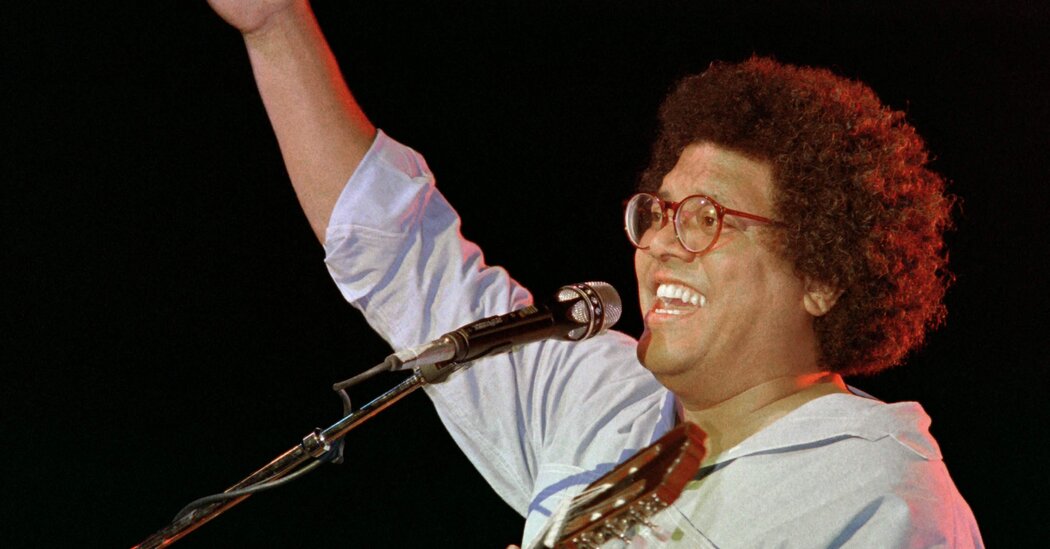
Pablo Milanés, who died in Madrid this week at 79, left behind a body of work that was deeply personal even as he navigated one of the 20th century’s most tumultuous political experiments, the Cuban Revolution. His career was an open dialogue with the revolutionary government that had once disciplined him, then propped him up as one of its most powerful ideological icons. More recently Milanés, who moved to Spain several years ago to seek cancer treatment, resumed his critical stance toward the Cuban government. But he never renounced his artistic labor, that of the singer with a story to tell about loves lost and won, a towering voice with a guitar and a sense of poetry and swing.
While some may define Milanés’s career as a product of a Cuban reality, long estranged from the United States, his art and its appeal had broad international repercussions. Having begun his career in his hometown, Bayamo, singing boleros and Mexican rancheras, he eventually collaborated with Latin American legends like the recently departed Gal Costa, as well as Milton Nascimento, Lucecita Benítez and Fito Páez. As one of the originators of the post-revolutionary genre nueva trova, he combined elements of Cuban son and guaracha with soul, jazz and folk rock.
His “Son de Cuba a Puerto Rico” from 1978 immediately changed the way I thought about the Caribbean’s sea-disrupted continuity, and the still-unfolding story of two former Spanish colonies. With its opening lyric — based on a poem by the early 20th-century Puerto Rican poet Lola Rodríguez de Tió — proclaiming that the two islands were “two wings of the same bird,” the song was an emotional reverie about divergent destinies and a desire for a shared future. “I invite you on my flight,” he crooned, “and we’ll search together for the same sky.”
Milanés’s first successful recording, “Mis 22 Años” (“My 22 Years”), released in 1965, was emblematic of the role he played in the evolution of trova in Cuba. The original trovadores were migrant troubadours who also dabbled in bolero and bufo, a kind of satirical musical theater, gradually incorporating Afro-Cuban rhythms. By the late 1940s, an update of trova called filin (a Spanish spelling of “feeling”) emerged, influenced by American jazz singers like Sarah Vaughan and Ella Fitzgerald. “Mis 22 Años” is grounded in filin, yet some consider it the first nueva trova song.
The nueva trova movement was supposed to represent a break from older traditions of socially conscious music in Cuba and help to define the “New Man” promoted by its leaders. It was a genre cobbled together from the voices of children of the revolution, some singing its praises, others challenging what they saw as restrictions. Milanés was deemed to be rebellious and, according to a 2015 interview he gave to El País, he spent time in UMAP, a forced labor camp where dissidents and homosexuals were sent.
In the 1970s nueva trova became a major force in Cuban music, with Milanés and Silvio Rodríguez, who openly borrowed from American folk-rock artists like Bob Dylan, its leading figures. While Milanés and Rodríguez often worked together and supported each other, in some ways they symbolized Cuba’s racial complexity. Milanés set poems by the Afro-Cuban poet Nicolás Guillén to music and collaborated with the Afro-Cuban filin singers Elena Burke and Omara Portuondo, while the lighter-skinned Rodríguez was famously connected with the folk singer Pete Seeger.
Milanés was most effective when he reached into those deeper recesses where Black singers find soul, like Al Green at his most yearning. His striking tenor was all the more powerful when it wavered in emotion — a slight trill paints the chorus of songs like “Yolanda,” dedicated to his former wife. In “La Vida no Vale Nada,” which insists that life has no value as long as there are victims of violence and the rest of us remain silent, Milanés is perhaps at his heart-aching best, sharply poignant, wounded yet determined.
Milanés’s syncopated swing and filin-flavored nueva trova translates a little more easily to the Puerto Rican wing of his mythical Caribbean bird. In 1994, a new salsa version of “Son de Cuba a Puerto Rico” was recorded by the Afro-Cuban singer Issac Delgado on “Con Ganas,” which was distributed by the U.S. label Qbadisc; it introduced him to American listeners and remains popular in Puerto Rico. In the improvisational section, Delgado name-checks the Puerto Rican favorites Rafael Hernández, Tite Curet, Cheo Feliciano and Ismael Rivera, and the rhetorical feel of the original becomes more of a dance party.
In the mid-1980s, Milanés wrote a song called “Yo Me Quedo” (“I’m Staying”), which resonated deeply with Puerto Ricans because it expressed a desire not to leave the Caribbean island that birthed him, seemingly intended to discourage out-migration. He even performed it in Puerto Rico, riding on its wave of loyalty and patriotism as he marched through reasons — the fragrant humidity, the “small, silent things” — that made it impossible to leave. A few years later, the Puerto Rican salsero Tony Vega covered it, indulging in all the materialist trappings of 1980s “salsa sensual,” yet still resonating with locals, losing nothing in the cross-Caribbean translation.
With Milanés’s passing, the contradictions of his life, and the juxtaposition of Cuba’s and Puerto Rico’s fates come into sharper focus. While the islands feature vastly different political systems, both struggle with electrical blackouts, economic austerity and often harsh living conditions that increasingly generate street protest.
Yet even as Milanés continued to speak out against the Cuban government, he was still allowed to return as recently as 2019 to perform massively popular concerts in Havana, performing classics like “Amo Esta Isla” (“I Love This Island”), a song he wrote around the same time he recorded “Yo Me Quedo.” It was a moment when ideology took a back seat to Milanés’s unparalleled talent as a troubadour of love, compelling everyone to reach for the sky.



